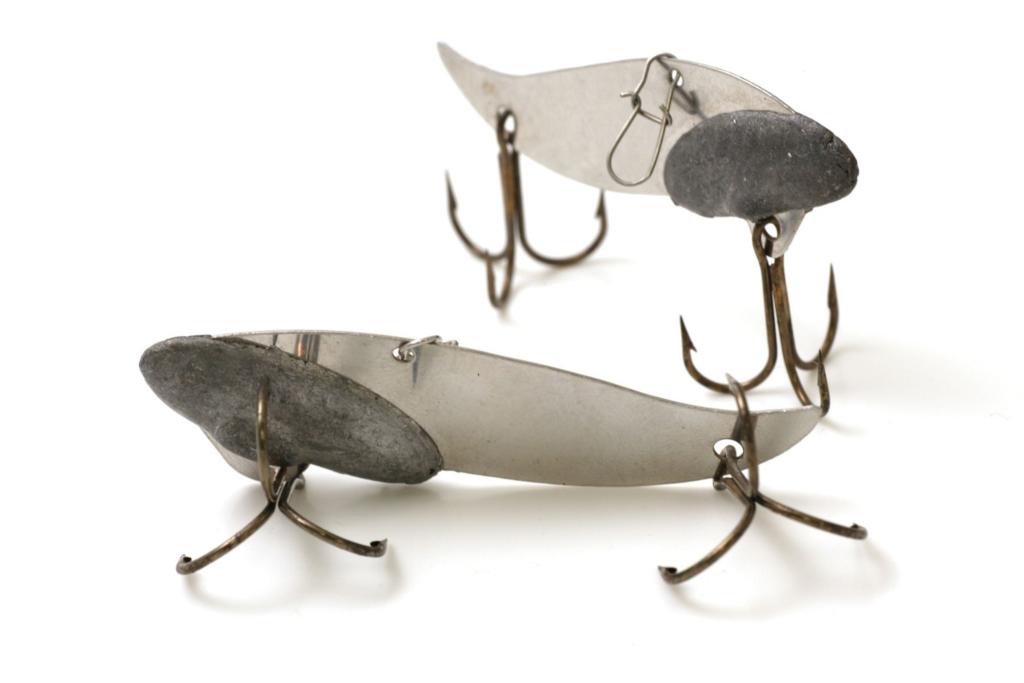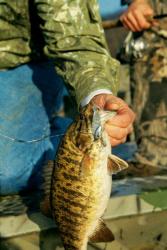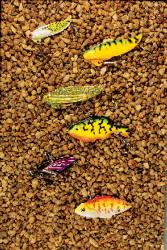Blade-runnin’ smallmouths
Cut to the point: blade baits for deep-winter smallmouths

It might have been the day he and a friend parked on a long, tapering point on a brisk December afternoon and caught one smallmouth bass after another. By the time the fish quit biting, the two anglers had boated 30 bass between 3 and 5 1/2 pounds. Or it might have been a bitter-cold February morning when the weather switched from heavy snow to sleet to a mix of rain and snow – miserable conditions by any angler’s standards – but the bass were slamming their baits. When the action finally ended, they had no idea how many chunky smallmouths they caught and released.
Then again, Jason Abram’s best day of winter smallmouth fishing could have been any number of outings. He’s had many in his years as a dedicated smallmouth angler in east Tennessee. Loads of big fish have ended up in his hands when many anglers were sitting at home dreaming of warm spring afternoons.
Winter is a great time to target smallmouths in highland lakes throughout the East. Tennessee, Kentucky, Virginia and a host of other states are home to some of the best smallmouth waters in the country, and winter is the best time to target concentrations of chunky fish.
Abram, a Wal-Mart FLW Tour pro from Chuckey, Tenn., said the single common denominator in his hot winter pattern isn’t the weather; it’s the lure – a half-ounce blade bait. He prefers a Silver Buddy, a flat piece of metal cut into the general shape of a baitfish with two treble hooks and a hole at the top that serves as a line tie. It’s a painfully simple lure that only vaguely resembles a real shad. Smallmouths don’t seem to care, though. Using it requires no special skills, except the desire to be on the water when the thermometer screams “cold!”
“Blade baits really become a good choice when the water drops into the mid- or low 50s. I’ve caught fish on them in water as cold as the high 30s, so there really is no bad time to try them in the winter,” Abram said.
Prime time
Wesley Strader of Spring City, Tenn., who fishes the FLW Tour and Wal-Mart FLW Series, said water temperature can determine the location of reservoir smallmouths. The colder the water, the more likely those fish are going to be on deeper points.
What’s going on above the water is less important than the water temperature itself. It’s the cold water that puts smallmouths in predictable locations and makes them easy to find. Abram, however, has experienced his best days during the worst possible weather. If it’s snowing, sleeting or blowing, he’ll drop what he’s doing, hook up his boat and head for the water.
“I don’t know why, but it seems like the worse the weather, the better the fishing,” Abram said. “Wind doesn’t seem to bother the fish nearly as much as it bothers the fishermen. It’s definitely not fun to fish in rough water this time of year, but I’ve done pretty well in those conditions.”
Strader, on the other hand, prefers bluebird skies. He’s a fanatic of the float and fly technique, a method of fishing that utilizes a bobber and a small hair jig. A blade bait is a backup for those days that aren’t suited for the fly rig, but it’s a great lure that he uses regularly.
“I’ll go to something like a Silver Buddy when the fish go deep, which is mostly on bright, sunny days,” Strader said. “In the clear water typical of a highland smallmouth lake in the winter, I find them  suspended along bluff walls on overcast or breezy days, which is when I go after them with a float and fly rig. Then the sun will push them deep, and that’s when I break out the Silver Buddy.”
suspended along bluff walls on overcast or breezy days, which is when I go after them with a float and fly rig. Then the sun will push them deep, and that’s when I break out the Silver Buddy.”
Most anglers agree that with winter smallmouth fishing – just as with any bass fishing – there are no absolutes. Smallmouths can be perplexing creatures that rarely adhere to the rules we set for them. They can be deep on cloudy days and relatively shallow on sunny days.
“It never hurts to try something. Just when I think I’ve got them figured out, someone catches them doing something I would have never thought of trying,” Strader said.
Get to the point
Drop them on any highland reservoir this time of year, and both anglers will head straight to the lower end of the lake. Abram isn’t sure if bass migrate toward the dam as the temperature drops or if those fish just happen to be easier to catch, but experience has taught him the lower third of any smallmouth lake is the place to be in the winter. Strader agreed, but as winter starts fading into spring, he focuses more on the upper end of the reservoirs he fishes. The slightly warmer water brought in by late-winter rains can increase feeding activity.
Wherever they happen to fish, both anglers start by searching for points. Instead of a random search, however, Abram and Strader focus on those main-lake points adjacent to the main river channel or where a major creek channel enters the main lake.
“I like to start with long, tapering points. They don’t always hold the most fish, but they do tend to hold fish more consistently than others and are the easiest place to locate smallmouths,” Abram noted.
Early in the winter or toward the early prespawn stage, usually in late February or early March in east Tennessee, he’ll work points inside creeks as bass start thinking about migrating toward spawning habitat. As spring progresses, Abram simply moves farther and farther back into long creeks. However, as spring blooms, other tactics tend to work better. He said blade baits are primarily a winter bait when bass are locked on deep structure.
Both anglers agree prime points will have baitfish on or near them, but the presence of shad, herring or alewives isn’t a critical ingredient. It does help, however, and Abram said bass seem to come alive if a school of bait is nearby.
“The great thing about locating bass on one point is you can focus on that depth range on other points,” Strader said. “They all tend to do the same thing. Bass won’t be on every point, but you can certainly hit those high-percentage areas that have similar ingredients as the first one where you caught fish. For instance, if I catch bass in 20 feet of water on one point, I’ll probably find them in 20 feet of water on another point.”
Tackle matters
Contrary to the lure style’s common name, Abram actually prefers gold Silver Buddies. He does far better on gold blade baits than on silver ones – even in the clear water typical of a highland smallmouth reservoir in the winter. Silver baits do work, he said, but gold is his go-to color, no matter what the conditions. What is his reason? Most anglers use silver and he simply wants to break tradition and give bass something they don’t always see. He’s not entirely sure fish can tell the difference that deep anyway. They see the flash and feel the vibration of the lure hopping up off the bottom, and they either eat it or they don’t.
“Sometimes you can switch colors when the fish quit biting, and you’ll start catching them again,” Abrams said. “If that doesn’t work, I’ll leave a spot and go looking for other smallmouths and then come back and work that point again. Either more fish move up or they were there all along. Maybe they got spooked or they just weren’t in the mood to eat, but give them an hour or two and they might turn on again.”
Strader agreed. He’s returned to a spot that surrendered a few bass only to catch several more. In fact, it’s a tactic that works repeatedly in the same day.
Cast or drop?
 The beauty of blade baits is they can be worked over prime spots in at least two ways. Abram and Strader each have a favorite, but they both admit either tactic will work. Both have advantages and disadvantages.
The beauty of blade baits is they can be worked over prime spots in at least two ways. Abram and Strader each have a favorite, but they both admit either tactic will work. Both have advantages and disadvantages.
“I usually cast mine and hop it back down a point. I like that method because I can cover a lot of ground in a single cast,” Abram said.
He starts by setting up on the outside end of the point, usually no deeper than 35 feet, and working his way in. As he eases toward the bank, Abram fan-casts to the top of the point and then to the sides, making sure he covers each point thoroughly. You really don’t know where bass will be, so it’s critical to work each point well.
He simply casts as far as he can, allowing the bait to fall to the bottom on a semi-slack line. If it’s too loose, he won’t feel a bite on that initial fall. If it’s too tight, the bait simply pendulums back to the boat.
“If you let the bait free-fall after you cast, it might wrap around your line. When that happens, it won’t look natural and you won’t get the vibration out of the lure that is so important with this method,” Abram explained. “You’ll notice as you rip it, the lure will vibrate really well. That’s one of the things about these types of baits that really gets the bass going.”
Once the lure touches bottom, Abram simply rips his rod tip skyward, pulling the bait 2 or 3 feet up off the bottom – or higher if he’s marked fish on his depth finder at a higher depth. Then he simply lets the lure fall again, but he reels in the slack as it falls. It’s a simple up-and-down action that keeps the bait in constant motion.
“You want to keep the line fairly tight, and you don’t want the bait to fall all the way to the bottom after each rip,” Abram said. “You’ll miss a lot of bites, and your line may get tangled in the hooks. I seem to get most of my bites right as the lure starts to fall after I rip it up.”
In order to prevent the inevitable snags that come with dropping a lure with two treble hooks on the bottom, Abram cuts the forward hook off the front treble, which helps dramatically. Still, he’ll go through a dozen blade baits in a hard day of fishing. If he gets hung, he’s simply putting his bait where the fish are. Fortunately, blade baits are relatively inexpensive.
Strader, on the other hand, drops his bait straight under his boat and works it much as he would work a spoon. Vertical jigging allows him to keep the bait in front of the fish longer, which might entice bass that aren’t in the mood to chase a faster-moving lure.
Like Abram, he tries not to let the lure free-fall on a slack like.
“It will get tangled up in the hooks every time if you just let it sink on slack line,” Strader said.
Once it hits bottom, Strader simply reels up to either the same level he marked fish on his depth finder, or he goes slightly above the fish. Bass, like a variety of other game fish, will go up to take a bait, but they generally don’t go down. When he gets his lure to the right depth, he simply raises and lowers his rod tip a few feet – just enough to give the bait some action. Sometimes, however, he rips it hard, raising his rod tip 5 or 6 feet.
“You have to try different things and let the fish tell you what they want. You never really know,” Strader said.
Like Abram, he won’t spend a lot of time on a specific point. If fish are there and they want to eat, they’ll typically take what he gives them. He does make sure he covers not only the point itself, but also the sides. Bass that are actively feeding might be chasing baitfish off to one side or the other.
“About 20 minutes is all I’ll spend on one point. If I’m confident there are fish under my boat, I might come back and work that point again if I didn’t catch them the first time,” Strader said.
What really matters more than how you use a blade bait is simply using it. Convincing yourself to uncover the boat and head for your favorite smallmouth lake while it’s snowing may take a little effort, but you’ll be rewarded once you do. You won’t have much competition, but once you start catching big smallmouths, you’ll wonder why everyone else is sitting at home waiting for warmer weather.